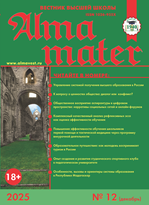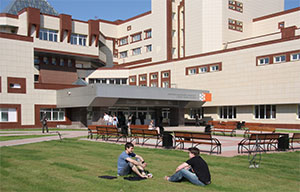Nina I. Lobanova, Cand. Sc. (Philosophy), Docent, Krasnoyarsk State Pedagogical University n.a. V.P. Astafiev, e-mail: nanakrasnoyarsk@yandex.ru
Larisa V. Logunova, Cand. Sc. (Philosophy), Docent, Krasnoyarsk State Pedagogical University n.a. V.P. Astafiev, e-mail: log1444@yandex.ru
The article is devoted to a comparative analysis of the effectiveness of two learning strategies (taking notes and “Listener’s Diary”). The article consists of two parts. The first part examines the problems and limitations inherent in such a traditional method of teaching as taking notes, and raises the question of its expediency when teaching a course of lectures on social sciences and humanities. The second part examines the possibilities of alternative ways of organizing students’ work during lectures using the example of the author's methodology “Listener’s Diary”, developed by a philosophy teacher at the Krasnoyarsk State Pedagogical University named after V.P. Astafiev and successfully implemented in non-core (non-philosophical) areas of study. The assessment of the difficulties associated with the application of this technique and its strengths is given taking into account the position of all participants in the educational situation (both teachers and students).
Keywords: learning strategies, taking notes, “Listener’s Diary”, effectiveness, lecture material, educational situation, work of thinking
References
1. Atabekova, A.A., Belousov, A.A., Gorbatenko, R.G. Classroom lecture: innovative potential for the university of the XXI century. URL: https://cyberleninka.ru/article/n/auditornaya-lektsiya-innovatsionnyy-po... (accessed on: 07.07.2024).
2. Astashova, T.A. Modern lecture at the university through the eyes of students and teachers. URL: https://cyberleninka.ru/article/n/sovremennaya-lektsiya-v-vuze-glazami-s... (accessed on: 07.07.2024).
3. Bourdieu, P., Passron, J.-K. Reproduction: elements of the theory of the education system. Moscow: Prosveshchenie, 2007. 267 p. (In Rus.)
4. Demin, T.S. The role of lectures as a learning format in a modern university. URL: https://libeldoc.bsuir.by/bitstream/123456789/53399/1/Demin_Rol.pdf (accessed on: 07.07.2024).
5. Lekhtsier, V.L. On the fate of lectures in the digital age: a theoretical review, an empirical analysis. URL: https://cyberleninka.ru/article/n/o-sudbe-lektsii-v-tsifrovuyu-epohu-teoreticheskiy-obzor-empiricheskiy-analiz (accessed on: 07.07.2024).
6. Lotman, Yu.M. Canonical art as an information paradox. In: Lotman, Yu.M. Selected articles. In 3 vols. Vol. 1: Articles on semiotics and typology of culture. Tallinn: Alexandra, 1992. 479 p.
7. Lotman, Yu.M. Dolls in the system of culture. In: Lotman, Yu.M. Selected articles. In 3 vols. Vol. 1: Articles on semiotics and typology of culture. Tallinn: Alexandra, 1992. 479 p.
8. Martinovich, N.I. The specifics of teaching philosophy. URL: https://izd-mn.com/PDF/03MNNPK19.pdf#page=104 (accessed on: 07.07.2024).
9. Riker P. Hermeneutics and psychoanalysis. In: Riker, P. Hermeneutics and psychoanalysis. Religion and faith. Moscow: Iskusstvo, 1996. 270 p. (In Rus.)
10. Alasmari, N. (2024). Saudi Students’ Note Taking Strategies: Perceptions and Difficulties. Theory and Practice in Language Studies, 14 (3), 796–802. URL: https://tpls.academypublication.com/index.php/tpls/article/view/7679 (accessed on: 07.07.2024).
11. Astra, I. M., Budi, E., & Evita, C. (2020). The effects of active learning model guided note taking on student’s critical thinking ability in high school. In Journal of Physics: Conference Series (Vol. 1521, No. 2, p. 022006). URL: https://iopscience.iop.org/article/10.1088/1742-6596/1521/2/022006/pdf (accessed on: 07.07.2024).
12. Ezekeke, E.C., Lawal, R.A., & Bello, Y. (2022). Lecturers’ Perception of the Note-Taking Challenges of College of Education Students in Kwara State, Nigeria. Journal of Lexicography and Terminology, 6 (1), 1–17. URL: https://journals.unza.zm/index.php/jlt/article/view/696 (accessed on: 07.07.2024).
13. Gorospe, M.M.J.M., & Abad, M.L.S. (2023). Note-taking behaviors of high school students. Journal of Multidisciplinary Studies, 3 (6), 200–211. URL: https://cognizancejournal.com/vol3issue6/V3I609.pdf (accessed on: 07.07.2024).
14. King, A. (1992). Comparison of self-questioning, summarizing, and notetaking-review as strategies for learning from lectures. American Educational Research Journal, 29 (2), 303–323. URL: https://citeseerx.ist.psu.edu/document?repid=rep1&type=pdf&doi=371fe6dff7a86df878c003b4b91d62a7096c73fe (accessed on: 07.07.2024).
15. King, A. (1993). From sage on the stage to guide on the side. College teaching, 41 (1), 30–35. URL: https://faculty.washington.edu/kate1/ewExternalFiles/SageOnTheStage.pdf (accessed on: 07.07.2024).
16. Marin, L., & Sturm, S. (2021). ‘Why aren’t you taking any notes?’ On note-taking as a collective gesture. Educational Philosophy and Theory, 53 (13), 1399–1406. URL: https://philpapers.org/archive/STUWAY.pdf (accessed on: 07.07.2024).
17. Trlifajová, M. (2023). Reflective Approach in Teaching Note-Taking. CLINA Revista Interdisciplinaria de Traducción Interpretación y Comunicación Intercultural, 9 (2), 161–182. URL: https://revistas.usal.es/dos/index.php/clina/article/view/31169 (accessed on: 07.07.2024).











.png)






